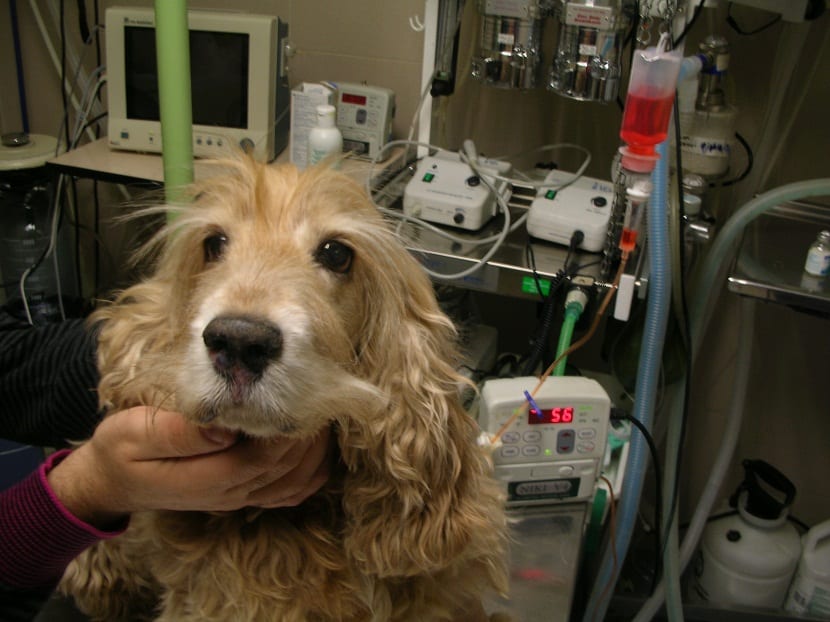
Canine leukemia is a serious condition that dogs can develop. The appearance of this disease usually occurs in very few cases, the incidence being 10%.
Larger breeds of dogs are the most likely to suffer from leukemia, in fact at six years of age, the risk of getting sick is much higher. Another thing to keep in mind is that this disease affects mostly females.
How does this disease affect dogs?

Canine leukemia occurs due to malignant neoplasms that occur within the bone marrow, being more specific in hematopoietic precursors. In this case, the cells do not have sufficient capacity to reach their maturation stage, so they remain in a poorly functional or immature state.
When it comes to a aleukemic leukemia, the disease directly affects the bone marrow, but does not do the same with the blood or only appears in small quantities. Because of this, the immune system is gradually being damaged, which considerably increases the risks that the dog could get sick.
What type of leukemia can dogs get?
This disease usually It is classified according to its origin and its development.
By its origin
Lymphoblastic leukemia: in this case there is an increase in the creation of lymphoblasts in the bone marrow. Sometimes it can be acute and sometimes chronic.
Myeloid leukemia: in this, the bone marrow tends to produce an irregular increase in the myeloid cells of the leukocytes. Like the previous one, it can be acute or chronic.
For its development
Acute leukemia: it appears abruptly and when it occurs, urgent treatment is necessary.
If it is not treated as quickly as possible, the animal could die in a short time, this means that its appearance is very serious. Acute leukemia is usually more common in feline species than in dogs. In this case, the cells do not reach the proper maturity, so they remain as immature cells.
Chronic leukemia: this kind of leukemia appears for a long timeIn fact, there are times when it is not detected for a long time. In chronic leukemia, the cells do reach maturity, however they do not fully mature. It is more common in older cats and dogs.
Causes of canine leukemia
There are many causes that can give rise to this dangerous disease that can end the life of our pet, however, there is still no exact knowledge of the reason for the appearance of leukemia in dogs.
Among these causes we can find the following:
- Genetic factor; affecting more large dogs and especially females.
- Strong exposure to ionizing radiation.
- Exposure to products made with chemicals.
- Infection due to certain bacteria that are capable of causing disease.
Canine leukemia symptoms

Dogs affected by this disease, do not usually have specific symptomsFor this reason, before any indication that our dog has unusual symptoms, it is necessary that we make a visit to the veterinarian as soon as possible.
The diagnosis of canine leukemia is very important, because if we can do it on time, we will prevent our dog from dying.
Among the most common symptoms, we can mention the following:
- Pain in the abdomen
- Loss of appetite
- Dangerous decrease in body weight.
- Lymph nodes overgrow.
- Increased heart rate.
- Difficulty breathing.
- Irregular breathing
Certain bone marrow-related symptoms which can vary depending on the type of leukemia, whether acute or chronic.
Types of leukemia
Acute leukemia
- Reduced hemoglobin or anemia as it is commonly known.
- Significant decrease in platelets circulating in the bloodstream.
Chronic leukemia
- Skin color lighter than usual.
Canine leukemia diagnosis
In most diseases, diagnosis is very important, since in this way the disease can be detected in time to treat it as quickly as possible, and in leukemia, this is vital for our dog.
After taking the dog to the vet, he will immediately begin performing what is known as the clinic history. For that, the expert will ask certain questions related to the animal's history, the moment in which the symptoms appeared, the most noticeable signs until the last day, if the dog is allergic or if we are treating it with any medication, if it suffers some kind of disorder, age, how much you weigh, sex, or if you ever had a sterilization.
These data are essential for the professional to be able to determine exactly what our pet is suffering from.
Subsequently, the vet will continue with a clinical-lesional diagnosis, where it will initiate a thorough inspection, in other words, it will perform a detailed analysis in order that nothing goes unnoticed, this is because anything that the professional may notice is vital to have a correct diagnosis.
The best way to confirm any suspicions that the veterinarian may have is through a laboratory diagnosis. In this part, it will be determined if the type of leukemia that the dog suffers from is acute or chronic.
Canine leukemia treatment

Dogs with a acute type leukemiaThey generally have a fairly prudent prognosis and most of the time they do not respond positively to the application of treatment. Really the chances that the dog will survive for a long time are very slim.
The treatment consists of chemotherapy application, so that a series of anticancer agents will be supplied to the pet.
This procedure will only be done occasionally. Will be used drugs that do not have a high level of toxicity in the bone marrow, such as vincristine. If it happens that there is no thrombocytopenia or severe neutropenia, drugs that have a greater myelosuppressive activity will be given, as is the case with doxorubicin or cyclophosphamide.
It is very important that we bear in mind that the vet will tell us with greater precision, what kind of treatment can be given the dog depending on the situation.
It is also necessary that we supply antibiotics due to possible risk of infection caused by a different bacteria, like pain relievers, to relieve pain that may affect the dog.
On the other hand, and if our dog suffers from chronic leukemia, then its prognosis will be much better than the previous case, however, it is necessary to apply treatment as soon as the disease is detected.
When chronic leukemia is diagnosed, dogs usually live a little longer than tiempo. The drugs used in these cases are prednisone in combination with chlorambucil.
These medications are given orally or intramuscularly and gloves are required, as this drug can be toxic.
The best thing is that we have the dog completely separated from other animals, since its defenses will drop considerably and we cannot risk a possible contagion of another kind of disease, because this could end the life of the animal.